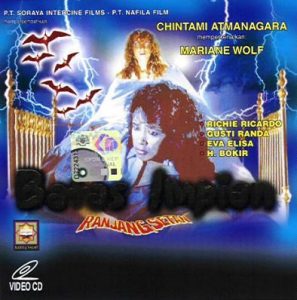Year: 1986
English Title: Satan’s Bed
Indonesian Title: Ranjang Setan
Production Company: Soraya Intercine, Nafila Film
Director: H. Tjut Djalil
Scriptwriter: Djoko S Koesdiman
Starring: Chintami Atmanegara, Mariane Wolf, Richie Ricardo, Linda Husein, Gusti Randa, A Hadi, Sofia, Doddy Sukma.
 Review from ‘Weird Asia’
Review from ‘Weird Asia’
Here’s another cool effort from H. Tjut Djalil who should be best known to you readers for his weird fantasy masterpiece MYSTICS IN BALI (1981) and the hugely entertaining exploitation spectacles LADY TERMINATOR (1988) and DANGEROUS SEDUCTRESS (1992). These three films are available as great DVD releases from Pete Tombs’s Mondo Macabro by the way! RANJANG SETAN (internationally known as SATAN’sS BED) rips off Wes Craven’s classic fantasy-slasher A NIGHTMARE ON ELM STREET (1985) for all its worth, pretty much in the same way as SRIGALA (1981) rips off FRIDAY THE 13TH (1980)! But while SRIGALA succeeded in improving on its role model (which isn’t that difficult, as Sean S. Cunningham’s slasher has got to be one of the most overrated movies in the history of cinema), this one unfortunately didn’t.
So what’s the movie about, you wanna know? It opens, promisingly enough, with a prologue taking place on 25th December 1941. We see a family with three kids celebrating Christmas in a huge, beautiful house. But disaster is already developing as a covered shape is pushing the barrel of a gun into the picture. The housekeeper is the first to notice that something is terribly wrong and after she gives a loud scream a bullet almost makes her right breast explode in slow motion! Then the whole family is systematically slaughtered, with the wife as the last to die after the killer has shot her in the belly. The dying woman’s hand touches the piano, on which they happily sung Christmas songs a few minutes ago, and a muffled sound drowns out the deathly silence.
After the opening credits that are accompanied by a dramatic, creepy music score, SATAN’S BED introduces us to a new family that lives in the house where those horrible murders took place forty-plus years ago. The villa now seems to belong to Mrs. Siska who lives in it together with her daughter Maria and her niece Nina. And before you can say “this might be a big mistake” strange things start to happen. For example, during a thunderstorm a lightning flash comes out of the TV screen and strikes the wall in front of which Maria is sleeping. The earth starts shaking and the next morning she and her friends nearly run a white-clothed cyclist (a priest who looks like American B-movie star Clint Howard) over. Later Nina takes a bubble bath and snoozes off, and is attacked by a mysterious hand with sharp blades instead of fingers that emerges out of the depths. She is dragged into the deep (there obviously is no bottom) but finally is able to free herself and escape into safety.
Later that night, when the mother has left the house, Maria and Nina invite two friends over to join them for some fun. But fun it ain’t, at least not for long. Because in the middle of the night Nina has a horrible nightmare that has bloody results in reality. A Freddy-Krueger-kind-of-guy with a blade-glove viciously attacks her in the dream and at the same time Nina’s chest is slashed open in her bedroom. Her shocked friend Rudy – who has to witness her brutal death helplessly – takes to his heels but is soon arrested as the prime suspect by the police in a park. Maria, who believes that Rudy is innocent, also meets the ugly guy with the disfigured face (after she sees the dead Nina walking around, wrapped into a plastic sheet) but the ringing bell from the alarm clock saves her right in time. Rudy isn’t that lucky though as the dream killer hangs him up on a tree. By now the occupants of the cursed house have realized that something is terribly wrong and they ask witch doctors to exorcise the house. They fail miserably. Then the incidents are happening in rapid successions: the housekeeper is killed, the mother is attacked and Maria is abducted into the dream world. A priest who passes by rather coincidentally intervenes. Is he able to stop the horror and save Maria?
As already mentioned in the first paragraph and as you’ve certainly found out yourself by reading the synopsis, SATAN’S BED is – I’m gonna formulate it kindly – heavily influenced by Wes Craven’s A NIGHTMARE ON ELM STREET. While the story behind the deadly nightmares is different the nightmare set-pieces themselves are often re-shot scene by scene by director H. Tjut Djalil. This begins with Nina’s killing in the bedroom and her appearance as a corpse wrapped in plastic, and it ends with Rudy’s hanging and little girls skipping in slow motion (complete with creepy music on the soundtrack). Of course you’ll also find the attack in the bathtub and Freddy – uhm, I mean the nightmare killer – cutting his own finger off which causes yellow blood to gush out of it. Would you be surprised if I tell you that Maria’s father is a policeman and her mother is addicted to alcohol? I don’t think so. Sadly both the tongue-coming-out-of-telephone-for-a-french-kiss scene and the Johnny-Depp-sucked-into-the-bed-and-gushing-out-in-a-fountain-of-blood sequence are missing in this Indonesian Nightmare version.
Although a lot of sequences are borrowed from the American pendant SATAN’S BED still has something “new” to offer. For example, in the first dream sequence Nina (who wears a white T-shirt with the inscription “This is my SEXY T-shirt” (frankly speaking it isn’t that sexy) rips off the dream killer’s head. This doesn’t prevent him from killing her (he slashes her belly open with his blade fingers; we don’t see him pulling her across the walls and the ceiling though) but at least it’s a nice special effect. Then the family decides to hire a witch doctor who should exorcise the house. This sequence is pretty cool and funny, with zombies tearing off their own heads who start attacking the man by biting him. After he fails miserably the family wouldn’t dream of giving up and hires another exorcist instead. This unfortunate guy has the dream killer growing inside of him who slashes his belly open from inside to free himself. If I’m not mistaken a similar scene was in Jack Sholder’s A NIGHTMARE ON ELM STREET II: THE REVENGE (1986), wasn’t it? Relating to the gore level SATAN’S BED is pretty much in the same league as the first two NIGHTMARE ON ELM STREET movies. There certainly is no over-the-top bloodshed, but the effects are okay (of course not as state-of-the-art as in its role models) and they are imaginative and quite bizarre.
Add to this a dark and creepy tone, beautiful and sexy girls (and women respectively), a few atmospheric sequences and a fine music score (that reminded me a bit on the music from Dario Argent’s PHENOMENA (1985), only it’s not that great) and you can’t deny that SATAN’S BED is a well-produced (by PT Soraya Intercine Film) if cheaply made fantasy flick that entertains very well for most of its eighty-three minutes running time. The girl who plays Maria (the Heather Langenkamp role) is okay, as are most of the other cast members. Only H. Bokir is quite an annoyance once again. I’m rather sure that the movie was shot in widescreen so the full screen image of the VCD destroys some of the moody and good camerawork. Although SATAN’S BED drags a bit from time to time (so much that it is nearly becoming boring), it still delivers plenty of the goods plus a spectacular showdown that even includes a flying skeleton! As a whole SATAN’S BED is an enjoyable trash flick with many cheap (and mostly not very convincing) special effects, some creepy scenes, a very good music score and a handful of good shock moments. It’s neither outstanding nor is it original, but it’s entertaining enough to provide eighty-three pleasant and trashy minutes. I enjoyed it… much. Not very much, just much. In 1991 Sisworo Gautama Putra directed a sort-of sequel called PERJANJIAN DI MALAM KERAMAT (more or less based on Renny Harlin’s A NIGHTMARE ON ELM STREET 4: THE DREAM MASTER) that manages to be more fun than the “original”.
RANJANG SETAN hasn’t had the luck of getting a DVD release yet. I’ve tracked down two VCD – the first one is from Malaysia and seems to be uncut, running 82 min. 59 sec., while the other one (released by the infamous Sky Vision label in Indonesia that also has put out the same director’s MISTERI JANDA KEMBANG (1991) with almost eighteen (!) minutes of cuts) is cut to pieces and only runs 76 min. 06 sec. From what I know the film was also released in France under the title CAUCHEMAR on tape, probably in the late 1980s or early 1990s. Strangely there are three different releases, all of them featuring different cover artwork. Plus SATAN’S BED also was released on tape in Germany. Both VCDs are presented in the full screen format without subtitles, original language of course. The picture quality is rather okay although the censored Sky Vision VCD is the better looking of the two, with sharper colours and more details.
original posted here:
http://www.avmaniacs.com/forums/showthread.php?t=32329








